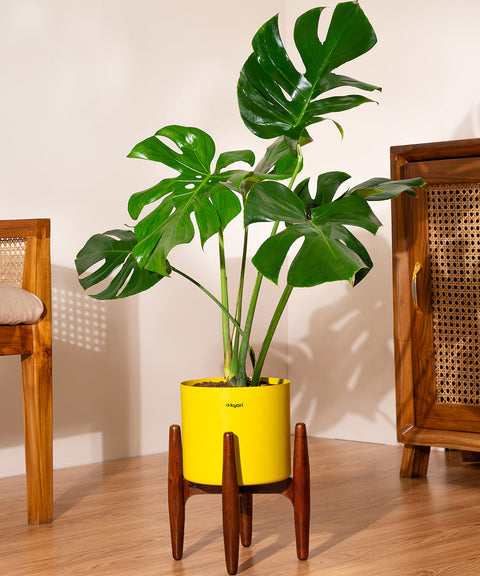You must have had a tulsi plant in your house growing up, with a fond memory of your mother watering it every morning, right? The Tulsi plant holds a major significance in Indian culture, tradition, and medicine. The Tulsi plant also holds a revered position within Hinduism, symbolizing spiritual purity and divine presence. From culinary delights to medicinal uses its aromatic qualities have led to its appreciation in various cultural and religious contexts beyond Hinduism.
Whether you are a neophyte or a seasonal gardener, having a good understanding of different types of tulsi can help you decide which tulsi is best for home. Therefore, in this blog, we will cover how many types of tulsi plants are available, their significance, and tips for growing a healthy tulsi plant. So let’s delve in…
What is the Tulsi Plant?
Tulsi plant, also known as Ocimum sanctum belongs to the mint family. It is known across the world for its medicinal properties. Not just Ayurveda, even modern science uses tulsi for its healing properties. It is effective in treating infections like a common cold, sore throat, and sinus.
Here are some uses and features of Tulsi Plants:
The holy plant of Tulsi has unique features that are multi-faceted. Here are some of the features of the Tulsi plant you should know about.
- Medicinal Uses of the Plant: Tulsi is used in Ayurveda to treat symptoms of various diseases like asthma, arthritis, bowel inflammatory disease, diabetes, and malaria. It is also used as a home remedy for colds, flu, and other infections.
- Benefits of Tulsi for Skin: Tulsi has antimicrobial properties, which is why its topical application can treat and prevent acne and pimples. Regular consumption of different types of tulsi can give you clear skin.
- Use of Tulsi for Weight Loss: Tulsi is known to increase the metabolism of lipids. This means you can burn more fat by consuming tulsi leaves. Many nutritionists suggest boiling tulsi leaves and drinking the water on an empty stomach to boost the fat loss process.
- Culinary uses: Tulsi leaves are used in salads, soups and various other dishes to get a distinct flavour. It is also brewed into concoctions and herbal teas that soothe the mind and relax the body.
- Repellents: The Tulsi plant with a strong aroma is also used as an insect repellent. This can be used as a natural repellent to eliminate the use of synthetic repellents.
- Aromatherapy: The tulsi plant is also used to extract essential oils. These oils are used in aromatherapy for calming and rejuvenating effects.
4 Different Types of Tulsi Plants in India
These are the different types of tulsi plants that you can find and grow in your home:
1. Purple Leaf Tulsi (Krishna Tulsi)
Also known as Krishna Tulsi or Shyama Tulsi, this variety of tulsi is known for its distinctive blueish-purple leaves. The dark colour of the leaves earns it the name of Krishna tulsi, after the name of Lord Krishna. Unlike the regular green ones, this type of tulsi is generally harder to find.
It had a strong clove-like odour and a pepper-like taste. It is considered very potent and is extensively used to treat many diseases in Ayurveda. Krishna tulsi is used to treat diseases like cholera, malaria, indigestion, insomnia, gastric issues, and the common cold and flu. It has a pungent taste and strong odour.
2. Green Leaf Tulsi (Rama Tulsi )
Green leaf tulsi or Rama Tulsi is quite popular in Indian households. It is also known as holy basil. Apart from India, it is commonly found in Asian countries like Sri Lanka and Malaysia. It has light green leaves and bears tiny purple flowers during the flowering season. Holy basil also holds prime significance in Hindu tradition.
The Rama Tulsi is extensively used for making tea and concoctions to relieve symptoms of colds like blocked nose, sore throat, and headaches. It is also boiled with water to relieve the symptoms of sinusitis. With these plethoras of benefits, it is also referred to as the elixir of life. Owing to the presence of eugenol, a compound that is also found in cloves, it has a taste and smell similar to cloves.
3. Wild Type 'Vana' Tulsi
Native to the forests of India, Sri Lanka, and Africa, Vana tulsi has light green leaves and a lemony fragrance. It is commercially cultivated for its medicinal benefits. It is considered to be less pungent in taste compared to other varieties of tulsi. Vana tulsi requires full sun and dry conditions to thrive. Believed to have adaptogenic properties, meaning it helps our body to adapt to stressors, this tulsi is used to make medicine for mental ailments like anxiety, stress, and insomnia.
4. Kapoor Tulsi
Kapoor Tulsi is generally found in India and Southeast Asia. It is also referred to as clove basil because of its clove-like aroma. It has small light green coloured leaves with pink or purple flowers and a strong scent. Its leaves are smaller and more elongated than other types of tulsi plant leaves. The dried Kapoor Tulsi leaves are used to prepare tea.
The Kapoor Tulsi is generally cultivated for its essential oil, medicinal use and religious purposes. This plant requires full sunlight and moist soil to flourish. It is also used as a cardioprotective, anti-fertility, anti-diabetic, anti-cancer, antifungal, and immune booster. Additionally, it is used in Thai cuisine as a spice.
Cultivation of Tulsi Plants: Grow & Care
If you are planning to plant any type of tulsi plant in your garden, but are unsure how to take care of it, we have got you covered. Here is everything you need to know about caring for your Tulsi plant:
- Location: Choose a sunny spot for your tulsi plant where it can receive at least 6-8 hours of sunlight each day. Tulsi prefers warm temperatures and cannot tolerate frost, so if you live in a colder climate, consider growing it indoors or in a greenhouse.
- Soil: Use well-draining soil to grow tulsi in a pot. Clayey soil can cause root rots in the plant. Opt for a potting mix soil with a pH level between 6.0 and 7.5. A mixture of potting soil and perlite or sand works well for container-grown tulsi plants. Ensure that the pot has drainage holes to prevent waterlogging.
- Watering: Keep the soil consistently moist but not waterlogged. Water the plant when the top 1-2 inches of soil feels dry to the touch. Avoid overwatering, as this can cause root rot. Tulsi plants are sensitive to chlorine, so it's best to use filtered or dechlorinated water if you live in a metro city. The residual water from air conditioners can be very good for watering your tulsi plants.
- Fertilising: The Tulsi plant needs nutrients in the growing and flowering stages. Feed your tulsi plant with a balanced organic fertiliser every 2-4 weeks during the growing season, that is, spring and summer. Organic fertilisers like manure and compost are the best fertilisers for tulsi plants. You can make liquid fertiliser at home with onion and banana peels too. Avoid fertilising in fall and winter because the plant is dormant in the winter season.
- Pruning: Regularly pinch back the growing tips of your tulsi plant to get a bushier growth and prevent it from becoming leggy. This will push your plant to grow more branches, instead of growing tall. Remove any yellowing or dead leaves to maintain the plant's health and appearance.
- Pest and Disease Control: Generally tulsi plants are durable and healthy and not prone to diseases. However, keep an eye out for pests like aphids, spider mites, and whiteflies, which can infest tulsi plants. Use organic pest control methods such as spraying with neem oil or insecticidal soap if necessary. Prevent fungal diseases by ensuring good airy soil and avoiding overhead watering.
Why Choose Kyari For Different Types of Tulsi
If you are looking to buy a Tulsi plant for your house, but have no time, you can easily order your Tulsi plant online from Kyari.
- At our online outlet, you can get various types of tulsi under one umbrella. Kyari is a one-stop shop for all your gardening needs.
- If you live in a metro city and are a beginner urban gardener, Kyaari can help you turn your home into a peaceful green haven.
- Check out Kyari to buy indoor plants, medicinal plants, ornamental plants, or plants for mental health.
- We also have a wide variety of aesthetic planters to choose from.
- Plus, we take every delivery seriously; each of our plants comes with a self-watering planter that helps it stay fresh on its way to your home.
FAQs on Types of Tulsi Plants
1. Which tulsi is best for home?
Even though all kinds of tulsi can be grown at home, religiously, Rama tulsi is considered to be more sacred and is most commonly grown at home.
2. What are the ayurvedic uses of Tulsi plants?
Tulsi is used in Ayurveda for its anti-inflammatory effects, antimicrobial properties and immunity-boosting effects. It is used to treat infections, the common cold, arthritis and many other diseases.
3. How do I care for a Tulsi plant?
Tulsi is a sturdy and durable plant and does not require special care. Just plant it in well-draining soil and keep it in a sunny spot. If you live in colder regions, keep the tulsi plant indoors during the winter months.
4. How to grow Tulsi step by step?
- Let’s find out how to grow Tulsi step by step.
- First, find a good place with adequate sunlight.
- Put some soil in the pot, now, plant the tulsi seeds and pour a little water.
- Now, keep watering the plant daily. Apart from that, you can also use some fertiliser occasionally.
- Additionally, pinch the Tulsi plant every now and then to make it more bushy.
- Following these steps, you can ensure a flourished Tulsi plant in your garden.








 Limited Time Deal
Limited Time Deal
 BYOB - Small Plants
BYOB - Small Plants
































































































